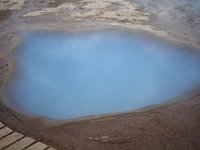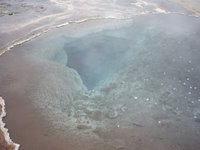Day twelve -- The Golden Circle
Getting used to the Icelandic language takes some doing. Icelandic is apparently the oldest form of the original Viking language, and since they've been isolated for so long, they claim that their language has not changed from the original Viking language, whereas Swedish, Norwegian and Danish have all evolved since then.
As such, Icelandic is totally unlike anything I've ever read, and it is very difficult to guess what words mean. Milk, for instance, is mjölk. Water, is vatn. But names (like streets and restaurants) are usually long-ass compound words with 20 or more letters, like Vesturbæjarlaug and Hofsvallagata. It's like chewing on an overfull mouthful of vowels and consonants.
Plus, Icelandic has two letters that we don't even use in our alphabet, the Eth (capital Ð, lowercase ð) and the Thorn (capital Þž, lowercase þ). The first is the soft "th" sound in "leather." 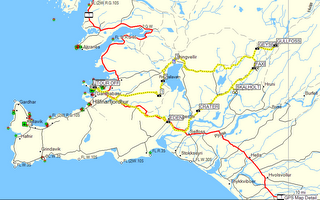 The second letter is the hard "th" sound, like in "Thor." It takes a practiced ear to hear the difference, but it seems to leave all the Icelandic people sounding like they have a slight lisp. Thankfully, they almost all of them speak near perfect English.
The second letter is the hard "th" sound, like in "Thor." It takes a practiced ear to hear the difference, but it seems to leave all the Icelandic people sounding like they have a slight lisp. Thankfully, they almost all of them speak near perfect English.
Today was devoted entirely to our Golden Circle tour. The Golden Circle is a great tour into the heart of southwestern Iceland. We boarded a bus at 9am and headed out of Reykjavík, heading east towards the mountains.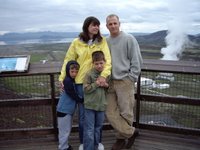 Our first stop was to visit the geothermal areas and steam fields that power Reykjavík. Huge steel pipes, encased in stone and wrapped in aluminum, carry the steam 30 miles from the mountains into the city. In the process, they only lose 1.8 degrees Celsius from the steam. The pipes are so cool that in winter snow will not melt on them.
Our first stop was to visit the geothermal areas and steam fields that power Reykjavík. Huge steel pipes, encased in stone and wrapped in aluminum, carry the steam 30 miles from the mountains into the city. In the process, they only lose 1.8 degrees Celsius from the steam. The pipes are so cool that in winter snow will not melt on them.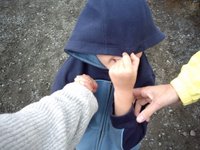 The mountainous area was extraordinarily picturesque, though it reeked of hydrogen sulfide (think rotten eggs). The hydrogen sulfide is, of course, what happens when geothermal steam and gas is released from the ground, one of the natural by-products of the earthly process.
The mountainous area was extraordinarily picturesque, though it reeked of hydrogen sulfide (think rotten eggs). The hydrogen sulfide is, of course, what happens when geothermal steam and gas is released from the ground, one of the natural by-products of the earthly process.
The steam captured in this area is between 200 and 400 degrees Celsius. Anything hotter than that and they can't control the geothermal process.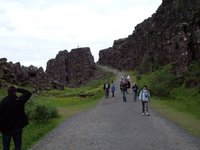 After the geothermal area, we headed north to Þžingvellir National Park, where we saw, in one view, the North American tectonic plate, the Eurasian plate, and the no-man's land in between the plates. Iceland sits at the merger of these two plates, and is literally being torn apart as the plates diverge. This is what causes all the geological activity here.
After the geothermal area, we headed north to Þžingvellir National Park, where we saw, in one view, the North American tectonic plate, the Eurasian plate, and the no-man's land in between the plates. Iceland sits at the merger of these two plates, and is literally being torn apart as the plates diverge. This is what causes all the geological activity here.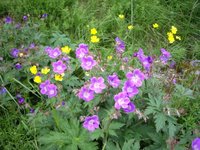 Huge rifts in the land define the faults, and the land is gorgeous in between. Wild buttercup and wild geraniums fill the valleys alongside streams and waterfalls. This is also the site of the first parliament where Viking settlers held their parliamentary discussions outdoors many hundreds of years ago.
Huge rifts in the land define the faults, and the land is gorgeous in between. Wild buttercup and wild geraniums fill the valleys alongside streams and waterfalls. This is also the site of the first parliament where Viking settlers held their parliamentary discussions outdoors many hundreds of years ago.
After Þžingvellir, we headed east to visit the great falls at Gullfoss. The falls were impressive, but to get too close meant getting wet, so we went instead to eat lunch in the very overcrowded cafe.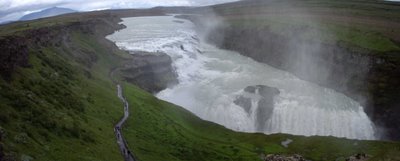
Next, it was over to the Geysir area, where we got to see several pools of geothermal water, some boiling, others still, and one in true bona-fide geyser form (Strokkur).
The Blesi pool was neat. It was two pools, connected by a thin strand and sharing the same water. The one on the left was a milky turquoise in color, the one on the right was as clear as it could be. What was the difference? The one on the right was fed from below, and it was near 100 degrees Celsius. The one on the left was not fed from below, but created as runoff from it's partner on the right. Therefore, it was cooler, and the minerals were precipitating out. The precipitate was mostly silica, and the water felt smooth and slippery on your fingers. It would have made a great bath, had I brought my suit!
 After the Geysers, we headed south to a small waterfall called Faxi, and though it was a brief stop, it was a nice visit and one of those "missed by most people" type of stops.
After the Geysers, we headed south to a small waterfall called Faxi, and though it was a brief stop, it was a nice visit and one of those "missed by most people" type of stops. Then, on to the old Christian church of Skálholt, which had some ancient ruins and a gorgeous cathedral, including an impressive mosaic of Christ on the altar wall. The stained glass was also very pretty. Simple, but pretty. Very Lutheran.
Then, on to the old Christian church of Skálholt, which had some ancient ruins and a gorgeous cathedral, including an impressive mosaic of Christ on the altar wall. The stained glass was also very pretty. Simple, but pretty. Very Lutheran.After this, we visited an explosion crater called Kerið. The crater was formed when the hot gases below the mountain build up and then, mixing with oxygen from the ice and water, explode, blowing the top off the mountain.
 The, rainwater and snow fills it with fresh water, making a nice lake. This lake is even stocked with trout today! I would have loved a quick dip, but again, no suit. Bummer.
The, rainwater and snow fills it with fresh water, making a nice lake. This lake is even stocked with trout today! I would have loved a quick dip, but again, no suit. Bummer.On the way back, our guide, Gumbi, who was really nice and very low key, told us some interesting stories. He started off by telling us about the Icelandic forest. Unfortunately, less than 5% of the island is forest, and it was supposedly mostly forest when the Vikings landed eons ago. And the Vikings, being a boisterous bunch, felled all the trees for timber. And since the growing season is so short, only about three months, the trees--even the old ones--are very small. So, the usual joke is:
"What do you do if you get lost in an Icelandic forest?"
"Stand up."
He also told us about the legends of elves, trolls and the hidden people. Elves, he said, are little benevolent creatures, welcomed by the people of the villages. Trolls are gigantic creatures which steal and plunder farms and houses. Trolls, however, cannot stand the light of day, and will turn to stone if caught in the sunlight, which explains all the large boulders found alongside the mountains.
Then, there are the hidden people, who are supposed to be the lost children of Eve in the garden of Eden. As the story goes, Eve and her children were going to get a visit by God. So Eve began to wash her children in preparation for their meeting of the Lord. However, God came, and Eve hadn't had time to wash all of the children, so the unwashed children were hidden.
The Lord asked, "Eve, are these all your children?"
"Yes," she replied.
God chastised her, and said, "Eve, if they are hidden from me, they shall be hidden from you forever."
The hidden people are like us in every way, both size and appearance. But they keep hidden in the mountains, and only choose to reveal themselves to ordinary people on rare occasions:
There's a legend of an old farm lady, who was milking her cow one day, when she was distracted by something in the house. Leaving her bucket, she investigated the noise, and when she came back, her bucket was empty.
She finished milking the cow, and took the milk, but left a small amount in the bucket. When she returned, the bucket was empty, washed and clean.
The next day, she did the same, leaving some milk in the bucket. Again, when she returned, the bucket was empty, washed and clean.
This went on for several weeks, and one night, the old lady had a dream that a hidden person, a woman, came to her and thanked her for the milk. The hidden woman said that she had an infant who was ill, and the milk had helped the child get better. In thanks, the hidden woman gave the old farm woman a beautiful shawl.
When the woman awoke, the shawl was folded on her bed. The shawl was beautifully embroidered, and was admired by everybody in the village. The old lady wore it with pride every day of her life, and when she died of a very old age, the shawl disappeared.
 Back on the road, before returning home, we visited an indoor greenhouse called Eden, of which the Icelanders were very proud. Being able to grow bananas in Iceland is quite an accomplishment. Luke and Eddie and I shared an ice cream, and we all enjoyed looking at the greenhouse.
Back on the road, before returning home, we visited an indoor greenhouse called Eden, of which the Icelanders were very proud. Being able to grow bananas in Iceland is quite an accomplishment. Luke and Eddie and I shared an ice cream, and we all enjoyed looking at the greenhouse.Then, it was back home to the hotel. We're about to go out for dinner at the Seafood Cellar restaurant, and then we'll be packing, for tomorrow we return home. Back to the ordinary life, back to work. But not before we make one more stop at the Blue Lagoon.
